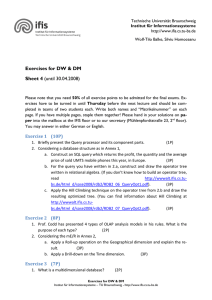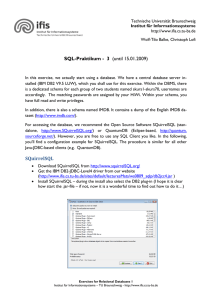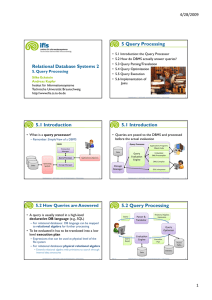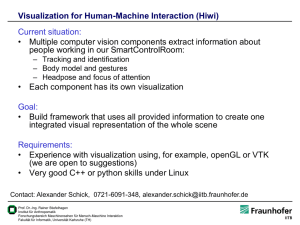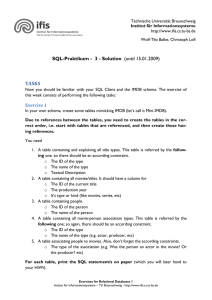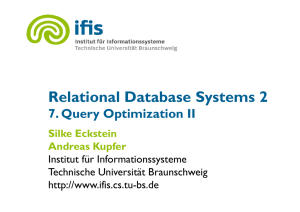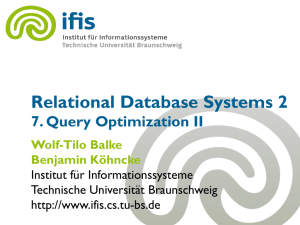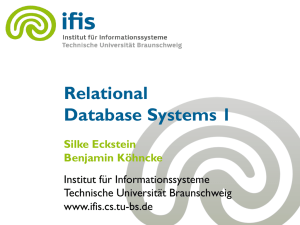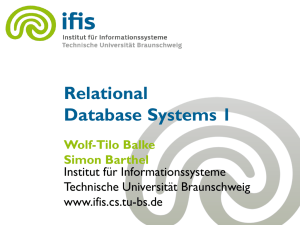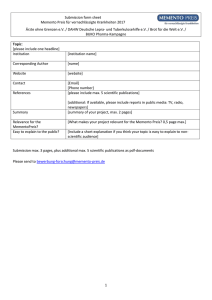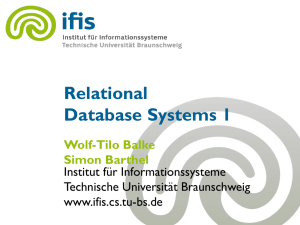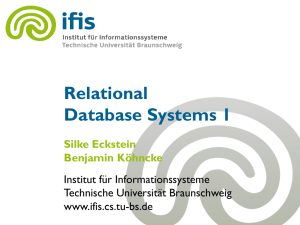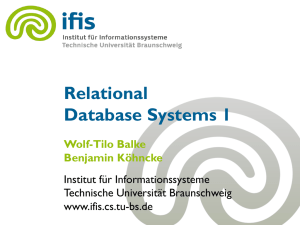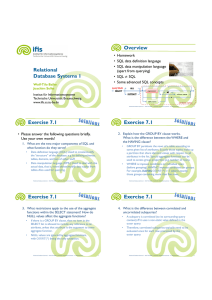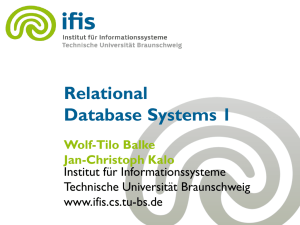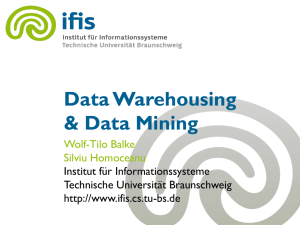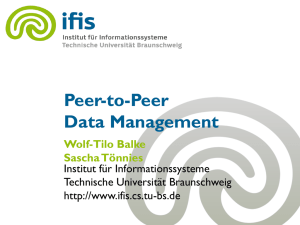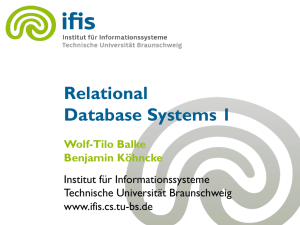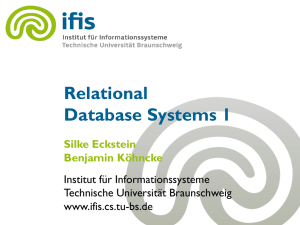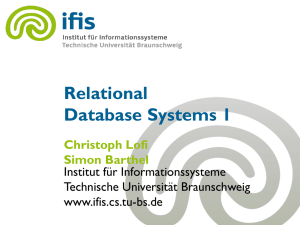Relational Database Systems 2 - IfIS
Werbung
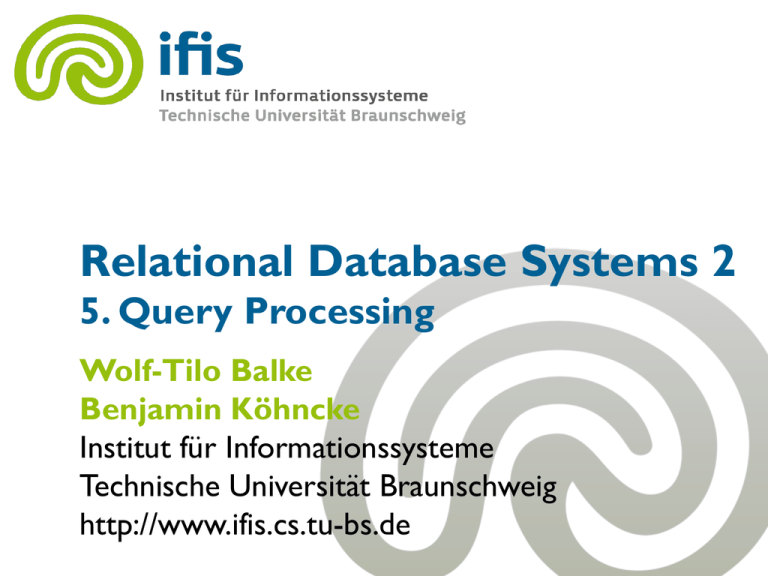
Relational Database Systems 2
5. Query Processing
Wolf-Tilo Balke
Benjamin Köhncke
Institut für Informationssysteme
Technische Universität Braunschweig
http://www.ifis.cs.tu-bs.de
5 Query Processing
•
•
•
•
•
•
5.1 Introduction: the Query Processor
5.2 How do DBMS actually answer queries?
5.3 Query Parsing/Translation
5.4 Query Optimization
5.5 Query Execution
5.6 Implementation of
Joins
Datenbanksysteme 2 – Wolf-Tilo Balke – Institut für Informationssysteme – TU Braunschweig
2
5.1 Introduction
• What is a query processor?
– Remember: Simple View of a DBMS
DBMS
Transaction
Manager
Query Processor
Disks
Disks
Disks
Operating
System
Applications /Queries
Storage Manager
Datenbanksysteme 2 – Wolf-Tilo Balke – Institut für Informationssysteme – TU Braunschweig
3
5.1 Introduction
• Queries are posed to the DBMS and processed
before the actual evaluation
Query Processor
Data
Storage
Manager
Query
Evaluation
Engine
Applications Programs
Object Code
Embedded
DML Precompiler
DML Compiler
DDL Interpreter
Datenbanksysteme 2 – Wolf-Tilo Balke – Institut für Informationssysteme – TU Braunschweig
4
5.2 How Queries are Answered
• A query is usually stated in a high-level
declarative DB language (e.g., SQL)
– For relational databases: DB language can be mapped
to relational algebra for further processing
• To be evaluated it has to be translated into a low
level execution plan
– Expressions that can be used at physical level of the
file system
– For relational databases: physical relational algebra
• Extends relational algebra with primitives to search through
internal data structures
Datenbanksysteme 2 – Wolf-Tilo Balke – Institut für Informationssysteme – TU Braunschweig
5
5.2 Query Processing
Query
Parser &
Translator
Relational Algebra
Expression
Query
Optimizer
Query
Result
Evaluation
Engine
Data
SKS 12.1
Execution
Plan
Access
Paths
Statistics
Datenbanksysteme 2 – Wolf-Tilo Balke – Institut für Informationssysteme – TU Braunschweig
6
5.3 Parser and Translator
• Queries need to be translated to an internal
form
– Queries posed in a declarative DB language
• “what should be returned”, not “how should it be returned”
– Queries can be evaluated in different way
• Scanner tokenizes the query
– DB language keywords, table names, attribute names,
etc.
• Parser checks syntax and verifies relations,
attributes, data types, etc.
Datenbanksysteme 2 – Wolf-Tilo Balke – Institut für Informationssysteme – TU Braunschweig
7
5.3 Parser and Translator
• Result of the scanning/parsing process
– Either query is executable, or error message is
returned (e.g., SQLCODE, SQLSTATE,…)
Datenbanksysteme 2 – Wolf-Tilo Balke – Institut für Informationssysteme – TU Braunschweig
8
5.3 Parser and Translator
• But often also like this…
Datenbanksysteme 2 – Wolf-Tilo Balke – Institut für Informationssysteme – TU Braunschweig
9
5.3 Parser and Translator
• Translation into relational algebra is necessary
for actually evaluating the query
– Internal exchange format between DBMS components
– Algebra allows for symbolic calculations
• Important for query optimization
– Individual operators
can be annotated with
execution algorithms
• Evaluation primitives
Datenbanksysteme 2 – Wolf-Tilo Balke – Institut für Informationssysteme – TU Braunschweig
10
5.3 Parser and Translator
• Evaluation primitives refer to a single
operator
– Tuple scan operators
– Tuple selection operators
– Index scan operators
– Various join operators
– Sort operator
– Duplicate elimination operator
–…
Datenbanksysteme 2 – Wolf-Tilo Balke – Institut für Informationssysteme – TU Braunschweig
11
Translating a Query
• A crash course relational algebra and SQL
– Basic operations
– Translation
Datenbanksysteme 2 – Wolf-Tilo Balke – Institut für Informationssysteme – TU Braunschweig
12
Relational Algebra
• Made popular by E.F. Codd 1970
• Theoretical foundation of relational databases
– Describes how to retrieve interesting parts of
available relations
– Lead to the development of SQL
– Relational algebra is mandatory to understand the query optimization process
• Topic of the next lecture
Datenbanksysteme 2 – Wolf-Tilo Balke – Institut für Informationssysteme – TU Braunschweig
13
Relational Algebra
• Defines six base operations
– Selection
– Projection
– Cartesian Product
– Set Union
– Set Difference
– Rename
EN 6
Datenbanksysteme 2 – Wolf-Tilo Balke – Institut für Informationssysteme – TU Braunschweig
14
Example Relations
courses
students
matNr
firstName
lastName
sex
crsNr title
1005
Clark
Kent
male
100
Intro. to being a Superhero
2832
Lois
Lane
female
101
Secret Identities 2
4512
Lex
Luther
male
102
How to take over the world
5119
Charles
Xavier
male
exams
6676
Erik
Magnus
male
student
course
result
8024
Jean
Gray
female
9876
100
3.7
9876
Logan
male
2832
102
5.0
1005
101
4.0
1005
100
1.3
6676
102
1.3
5119
101
1.7
EN 6
Datenbanksysteme 2 – Wolf-Tilo Balke – Institut für Informationssysteme – TU Braunschweig
15
Relational Algebra
• Selection ς
– Selects all tuples (rows) fulfilling a given Boolean
expression from a relation
– ς<condition>(R)
– Condition clauses:
• <attribute> θ <value>
• <attribute> θ <attribute>
• θ ∈ {=, <, ≤, ≥, >, ≠}
– Clauses may be connected by ∧,∨ and
EN 6
Datenbanksysteme 2 – Wolf-Tilo Balke – Institut für Informationssysteme – TU Braunschweig
16
Relational Algebra
• Selection Examples
ςsex=femalestudents
EN 6
matNr
firstName
lastName
sex
2832
Lois
Lane
female
8024
Jean
Gray
female
ςcourse=100
∧ result≥3.0exams
student
course
result
9876
100
3.7
Datenbanksysteme 2 – Wolf-Tilo Balke – Institut für Informationssysteme – TU Braunschweig
17
Relational Algebra
• Projection π
– Retrieves only attributes (columns) with given names
– π<attributeList>(R)
πtitlecourses
title
Intro. to being a Superhero
Secret Identities 2
How to take over the world
EN 6
πfirstName, lastName ςsex=femalestudents
firstName
lastName
Lois
Lane
Jean
Gray
Datenbanksysteme 2 – Wolf-Tilo Balke – Institut für Informationssysteme – TU Braunschweig
18
Relational Algebra
• Rename operator ρ
– Renames a relation S and/or its attributes
• Also denoted by ←
– ρS(B1, B2, …, Bn) (R) or ρS(R) or ρ(B1, B2, …, Bn) (R)
lectures
lectures ← πcrsNrcourses
crsNr
100
101
102
ρresults(matNo, crsNo, grade) ςcourse=100exams
EN 6
results
matNo
crsNo
grade
9876
100
3.7
1005
100
1.3
Datenbanksysteme 2 – Wolf-Tilo Balke – Institut für Informationssysteme – TU Braunschweig
19
Relational Algebra
• Union ∪, Intersection ∩ and Set Difference –
– Operators work as already known from set theory
• Operands have to be union-compatible (i.e. have to have
same attributes)
– R ∪ S or
R ∩ S or R-S
ςcourse=100exams ∪ ςcourse=102exams
EN 6
crsNr
title
100
Intro. to being a Superhero
102
How to take over the world
Datenbanksysteme 2 – Wolf-Tilo Balke – Institut für Informationssysteme – TU Braunschweig
20
Relational Algebra
• Cartesian Product ×
– Also called cross product
– Creates a new relation combining two relations in a
combinatorial fashion
–R×S
– Will create a new relation with all attributes of R and
all attributes of S
– Each entry of R will be combined with each entry of S
• Result will have |R|*|S| rows
EN 6
Datenbanksysteme 2 – Wolf-Tilo Balke – Institut für Informationssysteme – TU Braunschweig
21
Relational Algebra
badGrades
females
student
course
result
matNo
lastName
9876
100
3.7
2832
Lane
2832
102
5.0
8024
Gray
1005
101
4.0
badGrades ← ςresult≥3.0exams
females ← πmatNo, lastNameςsex=femalestudents
cross
student course
result
matNo lastName
9876
100
3.7
2832
Lane
2832
102
5.0
2832
Lane
1005
101
4.0
2832
Lane
9876
100
3.7
8024
Gray
2832
102
5.0
8024
Gray
1005
101
4.0
8024
Gray
EN 6
cross ← badGrades × females
Datenbanksysteme 2 – Wolf-Tilo Balke – Institut für Informationssysteme – TU Braunschweig
22
Relational Algebra
πlastName, title, resultςmatNo=student ∧ course=crsNo females × badGrades ×courses
lastName
course
result
Lane
How to take over the world?
5.0
• The combination of Projection, Selection and
Cartesian Product is very important for DB
queries
– This kind of query is called “join”
EN 6
Datenbanksysteme 2 – Wolf-Tilo Balke – Institut für Informationssysteme – TU Braunschweig
23
Relational Algebra
• Theta Join ⋈
– Creates a new relation combining two relations by
joining related tuples
– R ⋈ς(condition)S
– Theta joins can have similar conditions to selections
πlastName, title, result females ⋈ς(matNo=student)badGrades ⋈ς(course=crsNo) courses
≡
πlastName, title, resultςmatNo=student ∧ course=crsNo females × badGrades ×courses
EN 6
lastName
course
result
Lane
How to take over the world?
5.0
Datenbanksysteme 2 – Wolf-Tilo Balke – Institut für Informationssysteme – TU Braunschweig
24
Relational Algebra
• EquiJoin ⋈
– Joins two relations only using equivalence conditions
– R ⋈ (condition)S
– Condition may only contain equivalences between
attributes (a1=a2)
– Specialization of Theta Join
πlastName, title, result females ⋈matNo=studentbadGrades ⋈course=crsNo courses
≡
πlastName, title, resultςmatNo=student ∧ course=crsNo females × badGrades ×courses
EN 6
lastName
course
result
Lane
How to take over the world?
5.0
Datenbanksysteme 2 – Wolf-Tilo Balke – Institut für Informationssysteme – TU Braunschweig
25
Relational Algebra
• Natural Join ⋈
– Specialization of EquiJoin
– R ⋈ (attributeList)S
– Implicit join condition
• Join attributes in list need to have equal names in both
relations
• If no attributes are explicitly stated, all attributes with equal
names are implicitly used
EN 6
Datenbanksysteme 2 – Wolf-Tilo Balke – Institut für Informationssysteme – TU Braunschweig
26
Relational Algebra
females
badGrades
matNo
crsNo
result
9876
100
3.7
𝑅 ⋈(𝑎𝑡𝑡𝑟𝑖𝑏𝑢𝑡𝑒𝐿𝑖𝑠𝑡
2832
102
1005
101
)
𝑆 5.0
4.0
matNo
lastName
2832
Lane
8024
Gray
courses
crsNo
title
100
Intro. to being a Superhero
101
Secret Identities 2
102
How to take over the world
πlastName, title, result females ⋈matNobadGrades ⋈courses
EN 6
lastName
course
result
Lane
How to take over the world?
5.0
Datenbanksysteme 2 – Wolf-Tilo Balke – Institut für Informationssysteme – TU Braunschweig
27
SQL
• SQL (Structured Query Language)
– Most renowned implementation of relational algebra
– Originally invented 1970 by IBM for System R
(SEQUEL)
• Donald D. Chamberlin and Raymond F. Boyce
– Standardized multiple times
• 1986 by ANSI (ANSI SQL, SQL-86)
– Accredited by ISO in 1987 (SQL-87)
• 1992 by ISO (SQL2, SQL-92)
– Added additional types, alterations, functions, more joins, security
features, etc.
– Supported by most major databases
Datenbanksysteme 2 – Wolf-Tilo Balke – Institut für Informationssysteme – TU Braunschweig
28
SQL
• 1999 by ISO (SQL 3, SQL:1999)
– Added procedural and recursive queries, regular expression
matching, triggers, OOP features, etc.
• 2003 by ISO (SQL:2003)
– Added basic XML support, auto-generated keys and sequences, etc.
• 2006 by ISO (SQL:2006)
– Deeper integration with XML, support for mixed relational and
XML databases, XQuery integration
– However, most database vendors use proprietary
forks of the standards
• SQL developed for one DBMS often needs adoption to be
ported
Datenbanksysteme 2 – Wolf-Tilo Balke – Institut für Informationssysteme – TU Braunschweig
29
SQL vs. Relational Algebra
• Basic Select-Query Structure
– SELECT <Attributes>
FROM <Relation>
WHERE <condition>
• Map relational algebra to SQL
– π (attributeList) R : Select attributeList from R
– ς (condition) R : … where (condition)
Datenbanksysteme 2 – Wolf-Tilo Balke – Institut für Informationssysteme – TU Braunschweig
30
SQL
ςcourse=100
∧ result≥3.0exams
select * from exams where course=100 and result => 3
πtitlecourses
select title from courses
πfirstName, lastName ςsex=femalestudents
select firstname, lastName from students where sex=‘female’
Datenbanksysteme 2 – Wolf-Tilo Balke – Institut für Informationssysteme – TU Braunschweig
31
SQL vs. Relational Algebra
• Joins are explicitly indicated by the join keyword
– 4 types of “normal” join: inner, outer, left, right
students ⋈students.matNo=exams.studentexams
select * from students inner join exams on students.matNo=exams.student
• Joins are often also specified implicitly
– May lead to performance lacks as Cartesian product
may be computed
select * from students, exams where students.matNo=exams.student
Datenbanksysteme 2 – Wolf-Tilo Balke – Institut für Informationssysteme – TU Braunschweig
32
SQL vs. Relational Algebra
• Cartesian Product (implicit & explicit)
students × exams
select * from students, exams
select * from students cross join exams
• Natural Join
students ⋈ exams
select * from students natural join exams
Datenbanksysteme 2 – Wolf-Tilo Balke – Institut für Informationssysteme – TU Braunschweig
33
5.4 Query Optimization
• Several relational algebra expressions might lead
to the same results
– Each statement can be used for query evaluation
– But… different statements might also result in
vastly different performance!
• This is the area of query optimization, the
heart of every database kernel
– Avoid crappy operator orders by all means
– Next lecture…
Datenbanksysteme 2 – Wolf-Tilo Balke – Institut für Informationssysteme – TU Braunschweig
34
5.4 Query Optimization
πfirstName, lastName, resultςstudent=matNo ∧ course=100 students × exams
≡
πfirstName, lastName, resultςstudent=matNo (πfirstName, lastName, matNostudents ×
ςcourse=100exams)
≡
πfirstName, lastName, result(students ⋈ student=matNo (ςcourse=100exams))
Datenbanksysteme 2 – Wolf-Tilo Balke – Institut für Informationssysteme – TU Braunschweig
35
5.5 Query Execution
• The query optimization determines the specific
order of the relational algebra operators
– Operator tree
• Still each single relational algebra operator can
be evaluated using one of several different
algorithms
• The evaluation plan is an
annotated expression that
specifies a detailed evaluation
strategy
Datenbanksysteme 2 – Wolf-Tilo Balke – Institut für Informationssysteme – TU Braunschweig
36
5.5 Query Execution
• Cost of each operator is usually measured as
total elapsed time for executing the operator
• The time cost is given by
– Number of disk accesses
• Simply scanning relations vs.
using index structures
– CPU time
– Network communication
• Usually disk accesses are the predominant
factor
Datenbanksysteme 2 – Wolf-Tilo Balke – Institut für Informationssysteme – TU Braunschweig
37
5.5 Query Execution
• Disk accesses can be measured by
– (Number of seeks * average seek costs)
– (Number of block reads * average block read costs)
– (Number of blocks writes * average block write costs)
• Cost to write a block is more that cost to read it, as data
is usually read after writing for verification
• Since CPU time is mostly negligible,
it is often ignored for simplicity
– But remember In-Memory-Databases…
SKS 12.2
Datenbanksysteme 2 – Wolf-Tilo Balke – Institut für Informationssysteme – TU Braunschweig
38
5.5 Query Execution
• The select operator evaluation primitives
– Relation scan
– Index usage
– Relation scan with comparison
– Complex selections
SKS 12.3
Datenbanksysteme 2 – Wolf-Tilo Balke – Institut für Informationssysteme – TU Braunschweig
39
5.5 Relation Scan
• Used to locate and retrieve records that fulfill a
selection condition
• Linear Search over relation R
– Fetch pages from database files on disk that contain
records from R
– Scan each record and retrieve all rows fulfilling the
condition
• Cost estimate:
#pages containing records of relation R
– Half #pages on average, if selection is on a key attribute
• Scanning can be stopped after record is found
SKS 12.3
Datenbanksysteme 2 – Wolf-Tilo Balke – Institut für Informationssysteme – TU Braunschweig
40
5.5 Relation Scan
• Binary Search over ordered relation R
• only applicable, if selection is equality on ordered attribute
– Assume that relation R is stored contiguously
– Fetch median page from database files on disk that contain
records from R
– Decide whether tuple is in previous or later segment and
repeat the median search until record has been found
• Cost estimate:
log2(#pages containing records of relation R)
– Actually: cost for locating the first tuple
– Plus: number of additional pages that contain records
satisfying the selection condition (overflow lists)
SKS 12.3
Datenbanksysteme 2 – Wolf-Tilo Balke – Institut für Informationssysteme – TU Braunschweig
41
5.5 Index Scan
• Index Scan over relation R
• Selection condition has to be
on search key of an index
• If there is an index – use it!
– Equality selection on primary index for key
attributes
• Cost estimate: Height of the tree or 1 for hash index
– Equality selection on primary index for non-key
attributes
• Records will be on contiguous pages
• Cost estimate: (Height of the tree or 1 for hash index)
plus #pages that contain overflow lists
SKS 12.3
Datenbanksysteme 2 – Wolf-Tilo Balke – Institut für Informationssysteme – TU Braunschweig
42
5.5 Index Scan
• Index Scan over relation R
– Equality selection on secondary index
• Remember: records will usually not be on contiguous pages,
i.e. cost for page accesses will be much higher
• Cost estimate:
for secondary keys : Height of the tree or 1 for hash index
For non-keys: (Height of the tree or 1 for hash index) plus
#records retrieved
SKS 12.3
Datenbanksysteme 2 – Wolf-Tilo Balke – Institut für Informationssysteme – TU Braunschweig
43
5.5 Scan with Comparison
• For a comparative selection of form (R.a
value) generally a linear scan/binary search can be
used
– Simple range query
• If a primary index is available (sorted on a)
– For {>, } find first value and scan rest of relation
– For {<, } do not use index,
but scan relation until value
is found
SKS 12.3
Datenbanksysteme 2 – Wolf-Tilo Balke – Institut für Informationssysteme – TU Braunschweig
44
5.5 Scan with Comparison
• If a secondary index is available
– For {>, } find first value and scan rest of index to
find pointers to records
– For {<, } scan index and collect record pointers
until value is found
• In any case for the cost estimation:
– Every record needs to be fetched (plus costs of
locating first record)
– Linear file scan maybe cheaper, if many records have
to be retrieved
SKS 12.3
Datenbanksysteme 2 – Wolf-Tilo Balke – Institut für Informationssysteme – TU Braunschweig
45
5.5 Complex Selection Conditions
• Selection conditions can be joined with logical
junctors and, or and not
– Depending on the existence of indexes in some cases
a combination of the above algorithms can be used
• For conjunctions always choose the operation with
smallest selectivity for the relation scan and then test all
other conditions for records in main memory
• For disjunctions make sure that each block is only fetched
once
• For negations usually a linear scan is needed
– Often a complete linear index scan is cheaper anyway
SKS 12.3
Datenbanksysteme 2 – Wolf-Tilo Balke – Institut für Informationssysteme – TU Braunschweig
46
5.5 Sorting Operations
• Sometimes an operator needs to sort records in a
relation that is not already stored in sorted order
– “SORT BY”-clause in SQL for non-primary key
– Efficient processing of more complex operators, especially
set operations and joins
• With a secondary index on
the sort key the relation can
be read in-order
– Inefficient, since relation is only
sorted logically
SKS 12.4
Datenbanksysteme 2 – Wolf-Tilo Balke – Institut für Informationssysteme – TU Braunschweig
47
5.5 Sorting Operations
• Sorting is no problem, if entire relation fits into
main memory
– Quicksort & Co.
• If only some pages of a relation can be fetched
into the DB buffer, external sorting is needed
– most commonly used: Merge-Sort (n-way merge)
• Divide relation file into runs, sort each run separately in
main memory, and write all sorted runs back to disk
• Merge results by reading records from each run and
integrating them into the completely sorted result relation
SKS 12.4
Datenbanksysteme 2 – Wolf-Tilo Balke – Institut für Informationssysteme – TU Braunschweig
48
5.5 Sorting Operations
• Merge Sort by first name (assume 4 records fit
into buffer)
matNr firstName
matNr firstName
1005
2832
4512
Clark
Lois
Lex
5119
Charles
matNr
firstName
1005
Clark
9875
Bruce
4512
Lex
5119
Charles
2832
Lois
1005
Clark
6676
Erik
8024
Jean
5119
Charles
Run 1
6676
Erik
matNr
firstName
8024
Jean
4512
Lex
9875
Bruce
9875
Bruce
2832
Lois
6676
Erik
9967
Peter
9967
Peter
8024
Jean
Relation on Disk
9967
Peter
Relation on Disk
Run 2
SKS 12.4
Datenbanksysteme 2 – Wolf-Tilo Balke – Institut für Informationssysteme – TU Braunschweig
49
5.5 Projection
• Projection can be implemented by performing a
projection on each tuple
– Generally needs complete relation scan, since
relations are split horizontally over blocks
– If only non-key attributes are involved, duplicates
have to be removed
• Duplicate Elimination can be easily implemented using
sorting such that identical records
appear adjacent
• If merge sort is used duplicates can
already be deleted in each run,
before merging
SKS 12.6
Datenbanksysteme 2 – Wolf-Tilo Balke – Institut für Informationssysteme – TU Braunschweig
50
5.5 Set Operations
• All union, intersection, and set-difference
operations can be implemented by
– First sorting both relations
– Then scanning through each relation
– Producing the result relation by
• Union: omitting all records that occur in both relations
• Intersection: selecting only records that occur in both
relations
• Difference: retaining only records that are absent in the
other relation
SKS 12.6
Datenbanksysteme 2 – Wolf-Tilo Balke – Institut für Informationssysteme – TU Braunschweig
51
5.5 Set Operations
• Cost estimate:
– #pages in first relation + #pages in second relation
– Plus: sorting costs, if relations are not sorted
• Alternative implementation
– Partition both relations using the same hash
function
– Build an in-memory hash index for each partition
– Scan one partition and use the hash index of the
other relation’s respective partition to determine,
which records to choose for result of set operation
SKS12.6
Datenbanksysteme 2 – Wolf-Tilo Balke – Institut für Informationssysteme – TU Braunschweig
52
5.6 Join Operations
• Joins are a special type of the Cartesian product
• Joins usually have to access two different
relations
– Only records having a counterpart in the second
relation are in the result table
• Size of join results can be estimated via the selectivity of the
join condition and the number and overlap of distinct values
in both relations
– Sequences of joins spanning multiple relations
are also possible
SKS 12.6
Datenbanksysteme 2 – Wolf-Tilo Balke – Institut für Informationssysteme – TU Braunschweig
53
5.6 Implementing Joins
• Possibilities to implement joins include
– Nested loop join
– Block nested loop join
– Index nested loop join
– Merge join
– Hash join
SKS 12.6
Datenbanksysteme 2 – Wolf-Tilo Balke – Institut für Informationssysteme – TU Braunschweig
54
5.6 Implementing Joins
• Nested Loop Join (T1 ⋈ T2)
– Simplest Join
• Algorithm
– For each record r1 in T1 (outer loop)
• For each record r2 in T2 (inner loop)
– Compare r1 to r2 and add to result if they match
• Example Effort (block accesses; assuming block buffer size of 1)
– 6*(3+1) = 24
matNr
firstName
1005
Clark
2832
Lois
4512
Lex
5119
Charles
6676
Erik
8024
Jean
SKS 12.6.2
B1
B2
B3
B4
Directly compare all students
to all exams
B5
B6
matNr
result
9876
3.7
2832
5.0
1005
4.0
1005
1.3
6676
1.3
5119
1.7
Datenbanksysteme 2 – Wolf-Tilo Balke – Institut für Informationssysteme – TU Braunschweig
55
5.6 Implementing Joins
• Block Nested Loop Join (T1⋈ T2)
– Idea: Reduce block read overhead by prefetching
multiple records of T1
• Algorithm
– For every wsize records in T1
• Prefetch wsize records into window
• For each record r1 in window
– For each record in r2 on T2
» Compare r1 to r2 and add to result if they match
SKS 12.6
Datenbanksysteme 2 – Wolf-Tilo Balke – Institut für Informationssysteme – TU Braunschweig
56
5.6 Implementing Joins
• Example Effort (block accesses)
– assuming block buffer size of 1 and wsize = 2
– 3*(3+1) = 12 block accesses
matNr
firstName
1005
Clark
2832
Lois
4512
Lex
5119
Charles
6676
Erik
8024
Jean
matNr
B1
B2
B3
B4
B5
firstName
Compare window to T2
B6
SKS 12.6
matNr
result
9876
3.7
2832
5.0
1005
4.0
1005
1.3
6676
1.3
5119
1.7
Datenbanksysteme 2 – Wolf-Tilo Balke – Institut für Informationssysteme – TU Braunschweig
57
5.6 Implementing Joins
• Index Nested Loop Join (T1⋈ T2)
– Use indexes for inner loop to avoid scanning
• Index may be existing or temporary and just be created for
that single join
• May also be used within a block nested algorithm (with
window prefetching)
• Algorithm
– For each record r1 in T1 (outer loop)
• Add to result all records matching to r1 using index lookups
SKS 12.6
Datenbanksysteme 2 – Wolf-Tilo Balke – Institut für Informationssysteme – TU Braunschweig
58
5.6 Implementing Joins
• Example Effort (block accesses)
– assuming block buffer size of 1, wsize = 2 and index in
main memory
– 7 block accesses
firstName
1005
Clark
2832
Lois
4512
Lex
5119
Charles
6676
Erik
8024
Jean
SKS 12.6
B1
B2
B3
Use index to find
matches
Secondary Index on
matNr
matNr
B4
B5
B6
matNr
result
9876
3.7
2832
5.0
1005
4.0
1005
1.3
6676
1.3
5119
1.7
Datenbanksysteme 2 – Wolf-Tilo Balke – Institut für Informationssysteme – TU Braunschweig
59
5.6 Implementing Joins
• Merge Join (T1⋈ T2)
– Only useable for EquiJoins and NaturalJoins
– Adapts techniques from Merge Sort
• Algorithm
– If T1 and T2 are not sorted by join attributes
• Sort them into temporary tables
– Scan through both relations linearly (as in merge sort)
• Find matching tuples and add them to result
SKS 12.6
Datenbanksysteme 2 – Wolf-Tilo Balke – Institut für Informationssysteme – TU Braunschweig
60
5.6 Implementing Joins
• Example Effort (block accesses)
– assuming block buffer size of 2
– 6 block accesses when sorted before
• But sorting also needs effort
matNr
firstName
1005
Clark
2832
Lois
4512
Lex
5119
Charles
6676
Erik
8024
Jean
SKS 12.6
B1
B2
B3
“Merge” relations
linearly
B4
B5
B6
matNr
result
1005
4.0
1005
1.3
2832
5.0
5119
1.7
6676
1.3
9876
3.7
Datenbanksysteme 2 – Wolf-Tilo Balke – Institut für Informationssysteme – TU Braunschweig
61
5.6 Implementing Joins
• Hash Join (T1⋈ T2)
– Only useable for EquiJoins and NaturalJoins
• Algorithm
– Hash all tuples in T1 and T2 by their join attributes
• (Tuples with equal values will be in same bucket)
• For each bucket b
– Compare all tuples from T1 to all tuples from T2 and
add to result if they match
SKS 12.6
Datenbanksysteme 2 – Wolf-Tilo Balke – Institut für Informationssysteme – TU Braunschweig
62
5.6 Implementing Joins
• Example Effort (block accesses)
– assuming block buffer size of 1; hash table in memory
– 6 block accesses
matNr
firstName
1005
Clark
2832
Lois
4512
Lex
5119
Charles
6676
Erik
8024
Jean
SKS 12.6
B1
B2
B3
0
0
1
1
2
2
3
matNr
result
9876
3.7
3
2832
5.0
4
4
1005
4.0
5
5
1005
1.3
6
6
6676
1.3
7
7
5119
1.7
B4
B5
B6
Datenbanksysteme 2 – Wolf-Tilo Balke – Institut für Informationssysteme – TU Braunschweig
63
5.7 Query Execution
• Having a suitable evaluation plan annotated with
evaluation primitives for each operator, the query
can be executed
– For the result of each operator a temporary file has
to be created
– Temporary files can be input for other operators
• e.g., results of selection on relation may be input for some
Cartesian product
– Storing the temporary files on disk is expensive, but
necessary if DB buffer is small
EN 16.1.5
Datenbanksysteme 2 – Wolf-Tilo Balke – Institut für Informationssysteme – TU Braunschweig
64
5.7 Query Execution
• Creating a temporary file for each operator is
generally too expensive
– SQL statements consist of multiple basic operators
• Often algorithms for sequences of operations
are built
– Joins are a prominent example
– The code for such algorithms is usually generated
dynamically
– We will discuss this in detail during the next lecture
EN 16.1.5
Datenbanksysteme 2 – Wolf-Tilo Balke – Institut für Informationssysteme – TU Braunschweig
65
